-
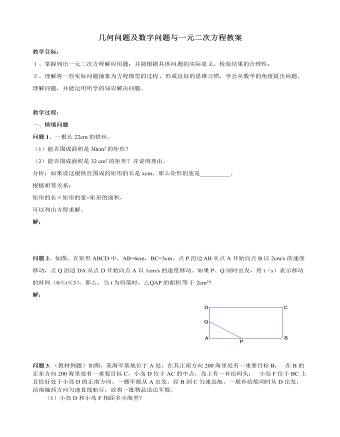
北师大初中数学九年级上册几何问题及数字问题与一元二次方程2教案
三、课后自测:1、如图,A、B、C、D为矩形的四个顶点,AB=16cm,BC= 6cm,动点P、 Q分别从点A、C出发,点P以3cm/s的速度向点B移动,一直到达B为止;点Q以2cm/s的速度向点D移动。经过多长时间P、Q两点之间的距离是10cm?2、如图,在Rt △ABC中,AB=BC=12cm,点D从点A开始沿边AB以2cm/s的速度向点B移动,移 动过程中始终保持DE∥BC,DF∥AC,问点D出发几秒后四边形DFCE的面积为20cm2?3、如图所示,人民海关缉私巡逻艇在东海海域执行巡逻任务时,发现在其所处的位置 O点的正北方向10海里外的A点有一涉嫌走私船只正以24海里/时的速度向正东方向航行,为迅速实施检查,巡逻艇调整好航向,以26海里/时的速度追赶。在涉嫌船只不改变航向和航速的前提下,问需要几小时才 能追上( 点B为追上时的位置)?
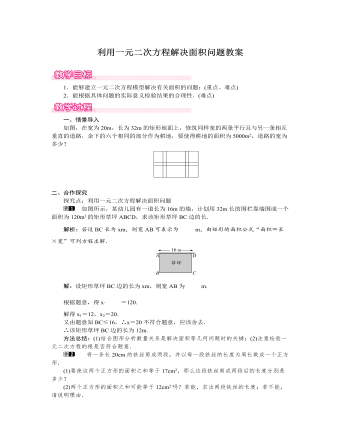
北师大初中数学九年级上册利用一元二次方程解决面积问题1教案
∴此方程无解.∴两个正方形的面积之和不可能等于12cm2.方法总结:对于生活中的应用题,首先要全面理解题意,然后根据实际问题的要求,确定用哪些数学知识和方法解决,如本题用方程思想和一元二次方程的根的判定方法来解决.三、板书设计列一元二次方程解应用题的一般步骤可以归结为“审,设,列,解,检,答”六个步骤:(1)审:审题要弄清已知量和未知量,问题中的等量关系;(2)设:设未知数,有直接和间接两种设法,因题而异;(3)列:列方程,一般先找出能够表达应用题全部含义的一个相等关系,列代数式表示相等关系中的各个量,即可得到方程;(4)解:求出所列方程的解;(5)检:检验方程的解是否正确,是否保证实际问题有意义;(6)答:根据题意,选择合理的答案.经历列方程解决实际问题的过程,体会一元二次方程是刻画现实世界中数量关系的一个有效数学模型.通过学生创设解决问题的方案,增强学生的数学应用意识和能力.
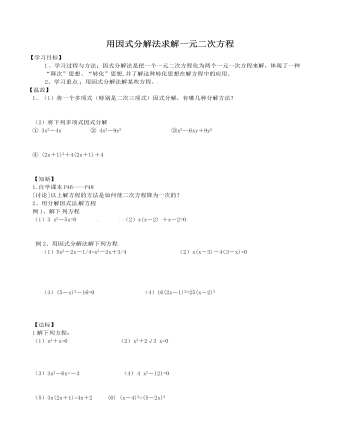
北师大初中数学九年级上册用因式分解法求解一元二次方程2教案
【学习目标】1 、学习过程与方法:因式分解法是把一个一元二次方程化为两个一元一次方程来解,体现了一种“降次”思想、“转化”思想,并了解这种转化思想在解方程中的应用。2、学习重点 :用因式分解法解某些方程。 【温故】1、(1)将一个多项式(特别是二次三项式)因式分解,有哪几种分解方法?(2)将下列多项式因式分解① 3x2-4x ② 4x2-9y2 ③x2- 6xy+9y2④ (2x+1)2+4(2x+1)+4 【知新】1.自学课本 P46----P48[讨论]以上解方程的方法是如何使二次方程降为一次的?2、用分解因式法 解方程例1、解下 列方程(1)3 x2-5x=0 (2)x(x-2) +x-2=0例2、用因式分解法解下列方程 (1)5x2-2x-1/4=x2-2x+3/4 (2)x(x-3)-4( 3-x)=0 (3)(5-x)2-16=0 (4)16(2x-1)2=25(x-2)2
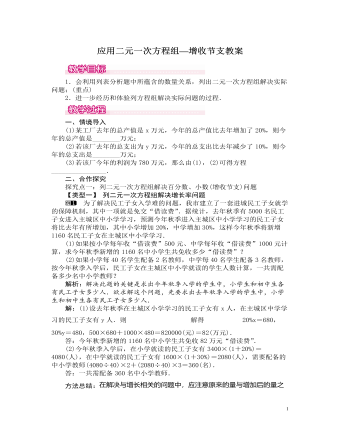
北师大初中数学八年级上册应用二元一次方程组——增收节支1教案
因为x3表示手机部数,只能为正整数,所以这种情况不合题意,应舍去.综上所述,商场共有两种进货方案.方案1:购甲型号手机30部,乙型号手机10部;方案2:购甲型号手机20部,丙型号手机20部.(2)方案1获利:120×30+80×10=4400(元);方案2获利:120×20+120×20=4800(元).所以,第二种进货方案获利最多.方法总结:仔细读题,找出相等关系.当用含未知数的式子表示相等关系的两边时,要注意不同型号的手机数量和单价要对应.三、板书设计增收节支问题分析解决列二元一次方程,组解决实际问题)增长率问题利润问题利用图表分析等量关系方案选择通过问题的解决使学生进一步认识数学与现实世界的密切联系,乐于接触生活环境中的数学信息,愿意参与数学话题的研讨,从中懂得数学的价值,逐步形成运用数学的意识;并且通过对问题的解决,培养学生合理优化的经济意识,增强他们的节约和有效合理利用资源的意识.
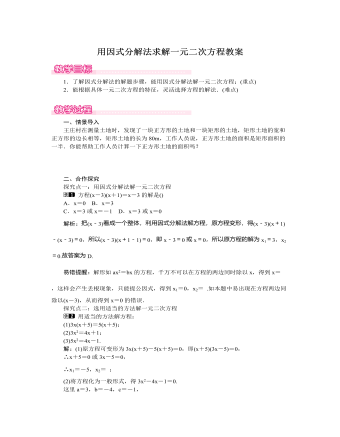
北师大初中数学九年级上册用因式分解法求解一元二次方程1教案
探究点二:选用适当的方法解一元二次方程用适当的方法解方程:(1)3x(x+5)=5(x+5);(2)3x2=4x+1;(3)5x2=4x-1.解:(1)原方程可变形为3x(x+5)-5(x+5)=0,即(x+5)(3x-5)=0,∴x+5=0或3x-5=0,∴x1=-5,x2=53;(2)将方程化为一般形式,得3x2-4x-1=0.这里a=3,b=-4,c=-1,∴b2-4ac=(-4)2-4×3×(-1)=28>0,∴x=4±282×3=4±276=2±73,∴x1=2+73,x2=2-73;(3)将方程化为一般形式,得5x2-4x+1=0.这里a=5,b=-4,c=1,∴b2-4ac=(-4)2-4×5×1=-4<0,∴原方程没有实数根.方法总结:解一元二次方程时,若没有具体的要求,应尽量选择最简便的方法去解,能用因式分解法或直接开平方法的选用因式分解法或直接开平方法;若不能用上述方法,可用公式法求解.在用公式法时,要先计算b2-4ac的值,若b2-4ac<0,则判断原方程没有实数根.没有特殊要求时,一般不用配方法.

小班美术《美丽的色彩》说课稿
新《纲要》提出幼儿美术教育的价值在于它激发情趣、激活兴趣;培养幼儿的创新意识;赋于幼儿满足感和成就感。传统的幼儿艺术教育要求通过模仿掌握技能、技巧,现代幼儿艺术教育则强调精神创造的意义;强调艺术活动对幼儿心理发展的影响。我选择了幼儿既感兴趣,又能充分动手动脑的美术创作活动——美丽的色彩,让幼儿自由选择活动内容,为他们提供丰富的材料、宽松的环境,尊重个体差异,为不同水平的幼儿考虑。通过“吸管吹画”、“弹珠滚画”、“手掌拓印”、“蜡笔涂画”等多种美术活动形式,让幼儿去体验、感受色彩的美丽以及活动带来的愉悦、满足感、成就感。

人教版新目标初中英语七年级上册Do you have a soccer ball教案
在这一单元中,学生要学会就有关人与物之间所属关系进行问答的句子。本单元大量引入有关运动的名词,要求学生彼此询问有无此类物品,并做出相应的回答。 同时学习表示建议的句型Let’s运动的形容词。 本单元所选用的话题来自学生所喜欢的生活片段,在教学中生生交流、师生交流会更融洽,会促进师生彼此间的了解,成功的教学还会让部分学生养成良好的运动习惯和收藏习惯。 教学目标 1) 语言知识:A.在询问对方是否有某物的对话中学会使用do和does引导的一般疑问句; B. 学会使用描述性的形容词来评价事物; C. 学会在对话中使用名词复数; D. 学会用祈使句来向对方提出建议. 2) 语言技能:A. 学会用祈使句询问某人是否有某物; B. 学会向他人提出建议的句子. 3) 学习策略:A.通过与同学讨论,做出猜测;

人教版新目标初中英语七年级上册Do you want to go to a movie教案
讨论喜欢的影视类型及理由:在看过一部影视作品后,大家总是喜欢在一起谈论影视的主要内容、主要情节、主要演员主题歌曲、主题音乐等,互相介绍自己对该影视的看法。教师可以组织一次活动,分组讨论学生喜欢看什么类型的电影,并说明喜欢的理由。运用I like…I don’t like…Because it is…等语言结构;然后每个组选派一名代表向全班学生阐述本组组员喜欢观看的电影类型;最后汇总,总结出全班同学最喜欢观看哪一种类型的电影。如果有可能,根据学生的选择放一部(一段)这种类型的影视节目。通过学生的讨论、调查,使他们在完成任务的过程中学会询问和陈述自己或别人在影视方面的喜好及理由,更好地巩固所学内容。Self Check教学内容Self Check(教材P58)教学目标知识与能力复习词汇go,movie,action,comedy,documentary,thriller,and,but,scary,funny, sad,exciting;引导学生复习、巩固“制订计划和打算并谈论喜好和偏爱”的目标语言。

人教版新目标初中英语七年级上册How much are these pants教案
个性练习设计 阅读广告:在日常生活中,人们去买东西之前,一般要阅读广告,从广告中获取该商品的一些有用信息,包括价格、性能等。所以给学生提供有些商品的广告或让学生去商店去阅读一些商品的广告,从中获取商品的价格,即可以锻炼学生的阅读能力,又能提高实践能力。 Self Check 教学内容 Self Check(教材P42) 教学目标 知识与能力 复习词汇pant,sock,T-shirt,sweater,shoes,color,black,white,red,green,blue,big,short,long,数字10--31; 学习词汇Zig Zag,clothes,shop,yellow,ask,which;学会谈论服装的价格、颜色、大小和长短;学会填写价格标签。 过程与方法 运用Summarizing和Classifying的学习策略。在复习教学中,运用听写、绘画、互相询问调查与检测等手段,促使学生不断地使用所学内容,从而提高他们灵活运用知识的能力。 情感态度价值观 该部分学习内容主要是复习谈论服装的价格和颜色以及对服装的喜好,能引起学生的共鸣;通过购物的对话练习教学生学会购物时使用的礼貌用语和如何感谢人。

人教版新目标初中英语八年级上册Can you come to my party教案3篇
Step 3 (3b)First, tell the students when we talk about our future plans, we often use: I’m+verb+ing When we talk about what we must do, we use have to. Ask the students to fill in the blanks in 3b. The answers are: shopping, go to see, a test, I’m going, my family. Step 4 (3c)Let the students write an e-mail message to a friend. Say why you can’t visit next. Before the exercise, ask the students to give some possible answers and write them on the blackboard. So the students will feel easy to finish the writing exercise. After they finish it, Let them to correct it in groups first. Each group chooses theirs best one to read in front of the whole class. Step 5 ( planning a party )First read the conversation in the box together. Then ask the students to turn to page 88.Write down everything you have to do next week. Write in all the things you have to do . Ask the students to look at the list. Ask them “What day are you free?” This is when you can have your party. Step 6 (Self check 1 )Let the students to fill in the blanks with the words given. Change the forms of the words if possible. Then make their own sentences. The answers are: visit, playing, have to, study, comeStep 7 (Self check 2)Imagine you are Marie. Read the information and look at your schedule. Write replies to the invitation.

人教版新目标初中英语八年级上册How do you make a banana milk shake教案2篇
1. First, ... then, ... next, ... finally, ...首先,……然后,……接着,……最后,……这是英语中表达做某事的步骤的一种说法。如果步骤较多,还可以说:first-next-after that-later on-finally/at last通常你会听到说英语国家的人在说 first, next, then, finally 和后面的内容时,他们会做一些停顿。这样就能提前告诉听者接下来讲的是一系列的步骤。这一点在朗读和听力中应特别注意。2. how many, how much均为疑问词,同是“多少”,但用法不同。请看:how many修饰可数名词复数,how much修饰不可数名词。但在用法上,同学们常犯如下错误:1) [误] How many are there bananas on the table?[正] How many bananas are there on the table?[析] how many, how much 中的many,much是形容词,常修饰名词作定语,故后面跟名词。2) [误]How much tea are there on the table?[正]How much tea is there on the table?[析] how much修饰不可数名词时,谓语动词用单数。how many与how much的区别可简记为:前how many:问“多少”,复数名词后面跑;how much问“多少”,不可数名词单数好。前者答语用基数词,后者答语用数量关系。

人教版新目标初中英语八年级上册Could you please clean your room教案3篇
一、 教学内容Section A 1a----1c二、 教学目标1.学习词汇do the dishes, make the bed, take out the trash, fold the clothes, do the laundry, sweep the floor, clean the living room.2.句型 Could you please clean your room? Yes, sure.三、 教学准备 学生预习本单元所有的词汇多媒体课件 活动表 奖品四、 教学过程Pre-task1. Warming upEnjoy ourselves. Watch cartoon Cinderella. 看动画片段《灰姑娘》导如入本课话题和新词汇“chores”美丽善良的鬼姑娘因继母的嫉妒,每天得做所有的家务。片段的主题使学生联想到本课的话题。2. learn new words and phrasesLook! What is she / he dong? 看图学习动词词组do chores, do the dishes, make the bed, take out the trash, fold the clothes, do the laundry, clean the living room.3. Guessing game.What is she doing ? 4. Pair work. 1a, Do you do these things at home? Write “Y” for “yes” and “N” for “no”.5. Listening . 1b , Peter’s chores or Mom’s chores?理解目标语Could you please clean your room? Yes, sure.Write “M” for Mom’s chores, “P” for Peter’s chores in the chart.6. PairworkLook at the picture,Ask your partner to do the chores that you see. 7. Interview Who is the most able at home? 1) What chores do you do at home? How often do you do the chores? Work in four, interview each of the students in the group, fill in the chart.

人教版新目标初中英语八年级上册I’m going to be a basketball player教案3篇
教学目标1.知识目标:(1)学习What are you going to be when you grow up?/How are you going to do that?句式。(2)学会用英语描述有关职业的表达法。2.能力目标:(1)能够谈论为实现理想所做出的打算和安排。(2)能够谈论未来自己与他人理想的职业及原因。(3)能用英语描述课余时间的活动安排,最终具备表达综合信息的能力。3.情感目标:新学期到来之际,让他们在学习、体育、饮食、特长、读书等方面制定计划,教育学生合理安排自己的课外生活,思考自己的理想职业及适合自己的职业。教学重点、难点本单元的重点为“be going to”表将来,want to be, what,where, when,how引导的特殊疑问句。难点是语言目标的实现。教材分析本单元以I am going to be a basketball player为话题,共设计了三部分的内容:一、Section A该部分有4个模块。第一模块围绕Do you think these jobs are interesting?这一话题展开思维(1a)、听力(1b)、口语(1c)训练;

人教版新目标初中英语八年级上册I’m more outgoing than my sister教案2篇
1 交通工具的比较此活动为小组活动。学生通过讨论找出到达某一城市可乘坐的各种交通工具,并选择最佳出行方式。Teacher:We’re going to Shanghai. How many ways can we use to get there? Yes, there are four ways: by bus, by plane, by train, by ship. Please discuss how you are going to get there.操作建议:(1)学生以小组为单位展开活动,谈论本组所选择的交通工具。(2)各组选代表向全班汇报,阐述本组所选择的交通工具的利和弊。完成任务所需要的语言结构:We can go there by ship. It’s more comfortable and cheaper than any other transportation.We can go there by bus. It’s cheaper but it takes longer time.2 哪个城市更合适?此活动具有挑战性。假设中国要举行2014年世界杯足球赛,分别从历史,人文,天气等方面对各城市(北京,大连,上海,昆明)进行比较,选择最佳举办城市。T: Imagine China is holding the 2014 FIFA World Cup. Which city do you think is the best for the World Cup, Beijing, Dalian, Shanghai or Kunming? Let’s work in groups. If you choose Beijing, please join the Team Red. If you chose Dalian, please join the Team White. If you choose Shanghai, please join the Team Blue. If you choose Kunming, please join the Team Green. Please show us its advantages. Then let’s see which team will win.

人教版新目标初中英语八年级上册What’s the matter教案2篇
She shouldn’t go to the party tonight.Step7. TaskT: You know, there are lots of problems in our life. If you are a doctor, please tell us how to solve the problem. I will divide you into 9 groups. Please work in groups. And then choose one of you to report your ideas.The following are the problems:I have a toothache.I am hungry. I have a sore throat.I am stressed out. I have a sore back.I am tired. I can’t sleep.I have a cold. I have a headache.Report: If you have a headache, you should go to bed early. You should see the doctor. You should eat some medicine. You shouldn’t wash your face with cold water.You shouldn’t sleep late.You shouldn’t swim.…..T encourages the students to give advice as much as possible.Homework:1. Chose one of the problems, and write down your advice2. Copy the new words这一步是用于热身的,同时也可以让他们复习一部分的表示人体部位的单词,扩充知识.学习语言的过程也是一个不断积累的过程,复习旧知识,增添新知识.通过小游戏,强化学生对Does she/he have…这个句子的运用能力.通过复习,自然的引到下面新知识的学习。充分利用表格,由句子到对话,再到文章,让学生循序渐进. 提高学生的综合语言运用能力,运用以前学过的知识来解决身边的问题.Period 5 (Section B 3a—3c, selfcheck)教学内容与分析:

人教版新目标初中英语九年级上册I like music that I can dance to教案
教学目标: 1. Express preferences2. Talk about one’s likes and dislikes and the reasons3. Learn to express one’s opinions 4. Learn to write a reply 语言功能: 1) Talk about one’s preferences, using t he relative clause2) Talk about people’s likes and dislikes and the reasons3) Talk about opinions语言结构: Relative clauses with that and who语言目标:What kind of music do you like?I like music that I can sing along with.I love singers who write their own music.We prefer music that has great lyric.重点词汇及短语:heart, photography, interest, class, whatever, miss, okay, expect, sweet, taste, itself, laboratory, cancer, increase, biscuit, main, care, prefer… to…, remind somebody of …, dance to, sing along with, be sure to, interest somebody, make somebody adj., to be honest, suit somebody, on display, catch up教学重难点:What do other people think of the different kinds of things? How to express one’s opinions? 学习方式:讨论,合作学习情感目标:通过本单元的学习,能提高学生的艺术鉴赏能力和审美情趣,并引导学生养成健康的饮食习惯。课时安排5课时第一课时:Section A: 1a-2c第二课时:Section A : 3a-4第三课时:Section B:1-2c, Self check2第四课时:Section B: 3a-4, Self check1第五课时:Self check ReadingI like music that I can dance to.

人教版新目标初中英语九年级上册I used to be afraid of the dark教案
内容提示1.本单元主要内容是学会used to结构。Used to +动词原形表示过去经常、以前常常,只用于过去式中,用来表示现在已不存在的习惯或状态。例如:They used to play football together.他们过去常在一起蹋足球。(现在不在一起踢了)2.used to的疑问形式和否定形式为Did you use to…?和I didn’t use to… 也可以用Used you to…?和I used not to…但现在多使用前者。例如:Did you used to swim in the river? 你过去常在河里游泳吗?I didn’t use to play the piano. 我以前并不经常弹钢琴。教学目标一、学习目标(Language Goal) 1.学会陈述自己过去常做的事情。2.学会陈述自己过去的爱好等。3.能够表达自己现在和过去在外表、性格、娱乐等方面的变化。4.能够表达朋友、家人等现在和过去的变化。二、语言结构(Language Structures) 1.I used to be short when I was young. 我年轻时个子很矮。 2. —Did you use to have straight hair? 你过去是直发吗?—Yes, I did. 是的。 3. —Did you use to play the piano? 你过去弹钢琴吗?—No, I didn’t. 不,我不弹。 4.I used to be afraid of dark. 我过去害怕黑暗。 5.I’m terrified of the snakes. 我害怕蛇。

人教版新目标初中英语九年级上册It must belong to Carla教案
一、Section A该部分有4个模块。第一模块围绕Whose volleyball is this? 这一话题展开思维( 1a)、听力(1b)、口语( 1c)训练;第二模块围绕上一模块中的话题进行听力( 2a-2b)、口语训练( 2c);第三模块继续围绕前两个模块中的“making inferences”展开训练。训练形式为阅读排序( 3a)和两人问答(3b);第四模块仍就上一话题展开讨论。二、Section B该部分有4个模块。第一模块要求根据图画和所提供的单词写出合理的句子;第二模块在听力( 2a-2b)和分角色口语训练( 2c)的基础上,继续进行“推测”训练; 第三模块围绕“Strange events in Bell Tower neighborhood”这一话题展开阅读( 3a)和写作(3b -3c)训练;第四模块以dream为话题展开小组活动。三、Self Check该部分有3个模块。第一模块以填空形式对所学词汇进行训练;第二模块就8个谚语展开阅读和讨论。

人教版新目标初中英语九年级上册Where would you like to visit教案2篇
The First PeriodⅠ.Teaching Aims and DemandsKnowledge Objects(1) Key Vocabularytiring, educational, fascinating, thrilling, peaceful, exotic, trek, jungle, take it easy, explore, historic, site(2) Target LanguageWhere would you like to go on vacation?I’d like to trek through the jungle, because I like exciting vacations.2. Ability Objects(1)Train students to talk about places they would like to visit with the target language.(2)Train students to describe vacations with different adjectives.(3)Train students' listening skill.3. Moral Object,It′s more interesting to go on vacating somewhere instead of staying at home.Ⅱ. Teaching Key Points1. Key Vocabularytiring, educational, fascinating, thrilling, peaceful, exotic, trek, jungle, take it easy, explore, historic, site2. Target LanguageTalk about different places with the target language.Ⅲ. Teaching Difficult Points1. Describe vacations with different adjectives.2. Talk about different places with the target language.Ⅳ. Teaching Methods1. Teaching by illumination2. Teaching by doing chain drills3. Teaching by pairworkⅤ. Teaching Aids1. A tape recorder2. Some pictures of different places with famous views

人教部编版七年级语文上册热爱生活,热爱写作教案
三、实战演练1.明确题干要求师:阅读教材P18的写作实践三,读读题干和“提示”,然后集中讨论一下,你是如何理解这个写作实践暗含的要求的。预设(1)这个题目可以简单概括为成长中的事件,范围比较宽广,类似于经常碰到的《难忘的一件事》一类的作文题。(2)一定要注意“成长”这个关键词,在描述这个事件时,一定要写出自己人生体悟的变化。(3)要选择一件有意义的、使“我”成长的事来写,在文末还应升华主题,写出自己在经历这件事后得到的人生启示。2.补充写作提示师:为了帮助大家完成好这次习作,老师在教材的基础上,还另外补充了三条“提示”。课件出示:提示:1.选材要小。选取生活中的一两个片段来刻画人物、表达感情。从小事入手,于细微处见精神,以小见大,突出“难忘”“印象深刻”。2.叙事要详略得当。叙事要围绕中心,抓住重点,把最能体现事件意义、最能展示人物形象的言行、心理描写得真实而详细。同时,要讲究剪裁,选取典型的、能揭示事物本质的、有说服力的材料表达中心思想,做到详略得当,主次分明。
